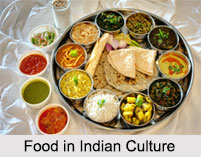 Food in Indian Culture played a great role in Indian tradition. Food is considered as a pious thing in India. The progress of any civilization banks upon the reformation of the base culture. Food in Indian culture is the reflection of all the historical, ethnic, geographic cultures in India. The most important aspect is the climate of the geographical region. India has a tropical monsoon climate which is conducive for a wide variety of vegetation to grow. Hence India is the native of thousands of plant species, condiments and spices.
Food in Indian Culture played a great role in Indian tradition. Food is considered as a pious thing in India. The progress of any civilization banks upon the reformation of the base culture. Food in Indian culture is the reflection of all the historical, ethnic, geographic cultures in India. The most important aspect is the climate of the geographical region. India has a tropical monsoon climate which is conducive for a wide variety of vegetation to grow. Hence India is the native of thousands of plant species, condiments and spices.
Every culture has been known to have its unique palette when it comes to Indian food. Although numerous religions appear in India, the two cultures which have influenced Indian cooking techniques and food routine are the Hindu and also the Muslim traditions. Indian meals reflect an ideal blend of various cultures and ages. Much like Indian culture, food in India has additionally been influenced by various civilizations.
Importance of Food in Indian Culture
Food is consumed as a factor of basic need for existence. Food brings people together. It is distributed as the sacrament in various religious ceremonies which brings every member of the community together irrespective their social status. Indian food is holds a great nutritional value. All the vegetables, legumes, herbs, grains, etc are loaded with important nutrients.
The traditional food of India has been widely appreciated for its fabulous use of herbs and spices. Foods of India are also known for its spiciness. Throughout India, whether it is North India or South India, spices are utilized generously in food. Each single spice utilized in Indian dishes carries some nutrition in addition to medicinal properties.
Indian cuisine is known for its large assortment of dishes. The cooking style varies from region to region and is largely divided into South Indian cuisine, North Indian cuisine, East Indian Cuisine, West Indian Cuisine, Central Indian Cuisine and North East Indian Cuisine.
Each new wave of settlers brought together their own culinary practices. However, with time people of India adopted lots of specialties and cooking methods in their cuisine. The Portuguese, the Persians and also the British made important contributions towards the Indian food culture. India is famous for its diverse multi-cuisine platter available in large number of food joints which is signifies of unity in diversity.




















